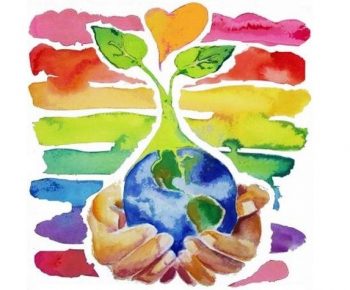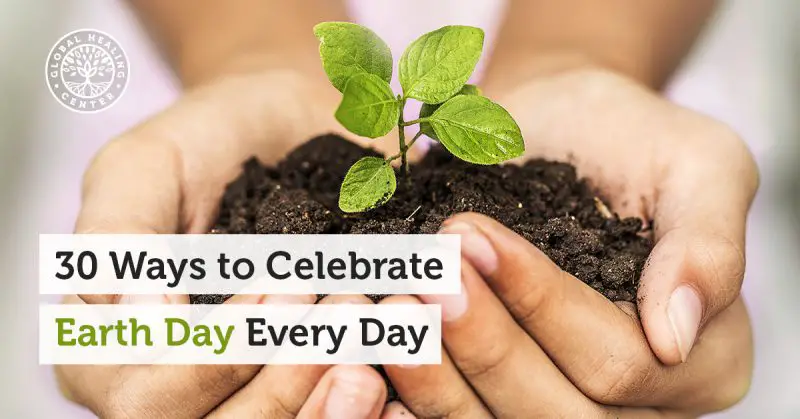April 17th, 2017
Guest writer for Wake Up World
Every April 22nd, millions of people in nearly 200 countries celebrate Earth Day, and I’m one of them. Originating in 1970, Earth Day is an opportunity for all of us to reflect on how we can make our Earth a better place; to be more mindful of our impact on the Earth and challenge ourselves to adopt new, environmentally friendly habits that conserve resources, save money, and encourage healthy living all-around.
In fact, with wonderful benefits like those, doesn’t it make sense to live every day like it’s Earth Day?
Well, you can. Over the years, my family and I have used Earth Day as a starting point to implement new and creative changes in our lives. Here are 30 ways we celebrate Earth Day that you and your family can try too. Some of them may seem small, and personal changes are no substitute for systemic reform — but small changes do add up, and if you sustain those changes for the rest of your life, they can profoundly lighten your environmental footprint and help make the Earth a better, cleaner place to live.
[pro_ad_display_adzone id=”110028″]
In Your Home
1. Use Essential Oils
Many candles, scented plugins, and room sprays contain toxic, synthetic fragrances. Instead of those, add pure or mixed essential oils to a diffuser or humidifier to spread a pleasant aroma throughout your home. Many essential oils boast health benefits or have calming effects on mood.[1]
2. Declutter Your Home
Spring is a great time to conduct a thorough home cleaning and discard, recycle, or donate all the unused items that are only taking up space. Make a conscious decision to keep the items that bring you joy and let go of the ones that don’t. Additionally, designate a spot in your home for every item you keep. Having a place for every item and returning it after use reduces clutter and will ensure you’re always able to find what you need, when you need it.
3. Use Lavender in Your Laundry
Many types of dryer sheets contain synthetic chemicals and fragrances. Ditch those and add about 20 drops of lavender essential oil to a damp washcloth or a few wool dryer balls and throw them in the dryer with your wet clothes. It’ll give your clothes a pleasant, natural scent that will even be noticeable throughout your home.
4. Adopt a Tree
A single tree can absorb up to 48 pounds of carbon dioxide every year.[2] If you live in an apartment or townhouse, get a small, indoor-friendly ficus. Yucca, kaffir lime, Madagascar dragon, or bonsai are other small trees that thrive indoors. Keep in mind that if you have pets, it’s best to double-check that the tree you select isn’t toxic to them.
5. Plant Flowers
Native flowers look beautiful and they provide pollen and nectar for pollinators like bees and hummingbirds.[3] Even better, locally-sourced flowers are typically low maintenance because they’re accustomed to your climate.
6. Use Natural Pest Control
Reduce your reliance on synthetic pest control methods like toxic powders and sprays. Encourage local insect-eating animals to visit the area around your home by installing a birdhouse or, if you dare, a bat house. You can also create a welcoming environment for predatory insects like praying mantises and ladybugs to help control pests. If you have slugs or snails, protect your precious plants with a sprinkle of diatomaceous earth.[4]
 Saving Energy
Saving Energy
7. Change Your Air Filter
There are many different types of air filters available, opt for the ones that are washable or made from eco-friendly materials. Reusable filters reduce waste and they’re more economical over the long run. Even better, clean filters improve the efficiency of air conditioners and can reduce energy costs.[5]
8. Seal the Door
A little air flow is a good thing but too much can work against your home’s heating and cooling efforts. Install a draft stopper on your door and seal up major cracks or leaks where you can. It’ll help you save on heating and cooling costs and keep pests out of your house.[6]
9. Take Cooler, Shorter Showers
According to the US Department of Energy, the water heater accounts for about 17% of the average American’s monthly energy bill.[7] In other words, it requires a lot of energy to heat water for a shower or bath. Taking a cooler, shorter shower can reduce energy use. As an added bonus, cold showers may help you feel more alert and reduce feelings of fatigue.[8]
10. Install a Smart Thermostat
Depending on where you live, central air conditioning might account for as much as 50% of your energy use.[9] To reduce waste, consider installing a smart, programmable thermostat. These devices shut off automatically when you’re away and have other built-in features that facilitate efficient heating and cooling.
11. Check Your Fridge
If you frequently find half-frozen produce or leftovers in the fridge, you’re ruining your food and wasting energy. Set your fridge to 37º F to reduce unnecessary energy use and keep your food fresh and unfrozen.[10]
12. Lower the Temperature on Your Water Heater
Water heaters are often set unnecessarily high, sometimes as high as 140º F. Lowering the settings to 120º F saves energy. And, since exceptionally hot water dries out your skin, it’s better for your complexion.
13. Put on a Sweater
If the house feels a little chilly, put on a sweater, warm socks, and cozy sweatpants. Prepare some herbal tea or a homemade soup rather than turning on the heater.
14. Keep Cool, Naturally
Consuming something cold is a great way to cool down. Stay hydrated. If it’s hot out, shed some layers and drink iced water or tea. Or, blend together and freeze organic frozen fruit to make a homemade sorbet.
15. Turn on the Fan
It’s easy to reach for the air conditioner when it’s too warm but, next time the heat gets too much, turn on a fan instead. Even the most efficient air conditioners account for a significant portion of your monthly energy expenditure. Fans use a tiny fraction of this energy.
16. Let There be Sunlight!
Open up the curtains and blinds to let in more natural light whenever possible. More than just conserving energy, sunlight helps your body produce vitamin D and strengthens your immune system.[11]
17. Skip the Shower
Consider whether or not you need a shower before taking one. Less frequent showers are becoming the norm once again. In fact, people used to bathe about once a week and just wash up at the sink the week leading up to their next bath. The idea of regular bathing became popular when soap salesmen created new consumer need by inventing the phrase “body odor” and the need for a daily shower.[12]
That said, personal hygiene is essential for your health and it’s something the people closest to you appreciate, but you might be showering too often. If you haven’t performed any strenuous activities, you might not need a shower. Additionally, keep in mind that some types of soap remove essential minerals, dry the skin and disrupt your skin’s microbiota, so try to use natural hygiene products wherever possible.[13]
18. Use Gentle Cleaners
When cleaning your home, use eco-friendly cleaning products instead of harsh, toxic agents. Plant-based cleaning solutions are widely available; you can find them at both big box stores and natural markets. Alternatively, castile soap or a simple solution of white vinegar diluted in water is an effective cleaner you can use on many types of surfaces.
19. Reuse Glass Containers
Before you recycle your glass bottles and jars, think about how you can reuse them. Large jars are great for salads and soups, small ones are the perfect size to measure portions of nuts and dressings. You can even reuse the dropper bottles from other products; just wash them out when you’re finished with them, and use them to hold or blend your favorite essential oils.
Transportation
20. Check Your Tire Pressure
Improve fuel efficiency and lower your pollution footprint by keeping your tires properly inflated. It’s also a good strategy for prolonging the life of your tires and, in turn, saving money.
21. Walk or Bike to Work
Not only is walking or biking to work great exercise, it reduces your pollution footprint. It can also be good for your mind — people that commute by car experience greater stress than people who walk, bike, and use public transportation, so it’s in your best interest to take a stroll to work.[14] As a bonus, you’ll also get a little exercise and some much-needed sunshine on your way.
22. Start a Carpool
If you have to drive, consider carpooling with coworkers in your neighborhood. You’ll help reduce pollution, decrease traffic congestion, and you get the bonus of social interaction before and after work. Studies report that talking to friends and coworkers offers substantial health benefits.[15]
Lifestyle
23. Eat Less Meat
If everyone cut back on their meat and dairy consumption, it would be a great contribution to the environment. Raising livestock requires an astounding amount of resources; it contributes to deforestation, habitat loss, greenhouse gas emissions, crop contamination, and water pollution.[16] Even worse, studies show that a high consumption of animal products can contribute to many chronic and debilitating diseases.
[pro_ad_display_adzone id=”110030″]
I don’t eat meat, but if you do eat meat, challenge yourself to replace it with plant-based food more often. Organic plants don’t have the same environmental impact as factory farming and a diet rich in plant-based food provides the specialized nutrition to support your health, and increase your lifespan. Starting a “Meatless Monday” habit is a great way to get started. If you like the results, take it a step further and become flexitarian, reducetarian, pescatarian, or semi-vegetarian to reduce your reliance on animal products even more.
24. Unplug and Go Outside
Today, too many people spend too much time indoors consuming media in some form or another — usually electronic. A climate-controlled environment requires energy to maintain, as do devices. Do yourself and the planet a favor by powering down, going outside, and enjoying nature with your friends and family. You don’t need to get on a plane to have an adventure. There might be some local undiscovered spot that will become your new retreat. National parks and nature preserves are resources many people don’t take advantage of and, unfortunately, parks that don’t receive a lot of visitors are at risk of being defunded, developed, or mined of their natural resources. Plan a visit to a less popular park to help protect its funding and maintenance.
25. Support Sustainable Businesses
If you can buy it, there’s an eco-friendly version of it. Support companies that use sustainable practices, ingredients, and packaging in their products. Many businesses have started incorporating recycled or upcycled materials into their products.
26. Get a Reusable Water Bottle
Disposable, plastic water bottles may be convenient but they release toxic plasticizers and hardeners that make their way into your body and the environment. Plastic does not degrade easily, and it may take up to 1,000 years to decompose.[17] Recycling is also a one-time-only process, explains Carolanne Wright:
“Conventional recycling programs are ineffective at best; only two types of plastic are widely recyclable, and even then, it’s downgraded into other products which cannot be recycled further, eventually ending up in landfill, or worse, in the ocean, where plastic seriously harms wildlife, the ecosystem and our health. … It’s naive to think the material will disappear all together.”
Instead of using plastic, buy a reusable water bottle made of glass and fill it with purified water every time you leave the house. It’s a habit that will reduce waste, and taking a water bottle wherever will encourage you to drink water more often and stay hydrated.
At the Office
27. Take a Plant to Work
Air purification devices are handy but wouldn’t it be great to clean the air naturally? Well, it turns out that you can literally clear the air of pollutants with certain plants. According to a NASA study, some plants help remove toxic compounds from the air. Florist’s Chrysanthemum is cited as the most broadly effective and reported to remove pollutants like benzene, formaldehyde, and ammonia; English ivy is another excellent choice.[18] Take a small desk plant to work and breathe a sigh of relief.
28. Take a Mug to Work
Disposable cups are convenient but using them is a tremendous source of waste. Even worse, most of the disposable cups you use every day are not recyclable and contain objectionable chemicals like styrene (found in Styrofoam), which is linked to neurological effects.[19, 20] Skip the disposable cups and bring your own mug to work. There are many nice options that are made with non-toxic materials.
29. Pack Your Lunch
In the United States, over 30% of food is thrown away at the consumer level.[21] That is a massive amount of waste and the majority of it ends up in landfills where it contributes to the production of greenhouse gasses.[22] Do the Earth a favor: save your leftovers and take them for lunch instead of going to a restaurant. If you have some veggies that have seen better days but are still good, turn them into a soup and pour it into jars for an easy grab and go lunch.
30. Stop Printing
The average American uses seven trees worth of paper and paper products every year.[23] That’s a lot of trees, and most of it ends up in the garbage. Whenever possible, avoid printing at work. A link or a PDF is often easier to keep up with and won’t clutter your coworkers’ desks.
Lasting Changes
Small changes add up quickly and can make a measurable difference on your pollution footprint and use of the Earth’s natural resources. Hopefully, these will provide a good start and encourage you to explore other areas such as using fewer disposable goods and recycling regularly. If everyone adopted just a few of these changes, we could significantly reduce our collective impact on the Earth.
What changes have you made to reduce your environmental impact? Tell us about them in the comments below, or join the conversation on Facebook!
References: See below.
Recommended articles by Dr. Edward Group:
- The Benefits of Apple Cider Vinegar
- The 9 Best Fermented Foods for Your Gut
- 14 Foods that Cleanse the Liver
- Top 5 Foods for the Pineal Gland
- 6 Things You Must Know About Colloidal Silver
- The Importance of a Kidney Cleansing Diet
- The 9 Best Herbs for Lung Cleansing and Respiratory Support
- 7 Best Foods to Support Kidney Function
- Lung Cleansing With Peppermint Oil
- How Fluoride Damages Pineal Gland Health
- The Top 20 GMO Foods and Ingredients to Avoid – and Why
- How Does the Alkaline Diet Affect Gut Health?
- 15 Best Essential Oils and Their Health Benefits
About the author:
 Dr. Edward F. Group III (DC, ND, DACBN, DCBCN, DABFM) founded Global Healing Center in 1998 and is currently the Chief Executive Officer. Heading up the research and development team, Dr. Group assumes a hands-on approach in producing new and advanced degenerative disease products and information.
Dr. Edward F. Group III (DC, ND, DACBN, DCBCN, DABFM) founded Global Healing Center in 1998 and is currently the Chief Executive Officer. Heading up the research and development team, Dr. Group assumes a hands-on approach in producing new and advanced degenerative disease products and information.
Dr. Group has studied natural healing methods for over 20 years and now teaches individuals and practitioners all around the world. He no longer sees patients but solely concentrates on spreading the word of health and wellness to the global community. Under his leadership, Global Healing Center, Inc. has earned recognition as one of the largest alternative, natural and organic health resources on the internet.
For more information, please visit Global Healing Center.
Article references:
- Braun, Lesley and Marc Cohen. “Herbs & Natural Supplements.” 1st ed. Sydney: Elsevier Australia, 2015. Print.
- “Tree Facts.” NC State University. Web. 10 Mar. 2017.
- “Native Pollinators.” Natural Resources Conservation Service- Wildlife Habitat Management Institute. N.p., 2017. Web. 10 Mar. 2017.
- “Pest Management | NRCS.” USDA .gov. N.p., 2017. Web. 10 Mar. 2017.
- “Maintaining Your Air Conditioner.” Energy.gov. N.p., 2017. Web. 10 Mar. 2017.
- “Air Sealing Your Home | Department Of Energy.” Energy.gov. N.p., 2017. Web. 10 Mar. 2017.
- “Home Water Heating.” Energy.gov. N.p., 2017. Web. 10 Mar. 2017.
- “Effectiveness Of Rest, Abdominal Cold Packs, And Cold Showers In Relieving Fatigue: Research Quarterly. American Association For Health, Physical Education And Recreation: Vol 39, No 3.” Shapeamerica.tandfonline.com. N.p., 2017. Web. 10 Mar. 2017.
- “Heat & Cool Efficiently.” Energystar.gov. N.p.,
- “Best Refrigerator Temperature To Keep Food Fresh.” Consumer Reports. N.p., 2017. Web. 10 Mar. 2017.
- SJ, Hobday. “Roles Of Sunlight And Natural Ventilation For Controlling Infection: Historical And Current Perspectives. – Pubmed – NCBI.” Ncbi.nlm.nih.gov. N.p., 2017. Web. 10 Mar. 2017.
- Vinikas, Vincent. “Soft Soap, Hard Sell.” 1st ed. Ames: Iowa State University Press, 1992. Print.
- Grice, Elizabeth A., and Julia A. Segre. “The Skin Microbiome.” Nature Reviews Microbiology 9.4 (2011): 244-253. Web. 19 Mar. 2017.
- “Affective Appraisals Of The Daily Commute – Jul 26, 2016.” Journals.sagepub.com. N.p., 2017. Web. 10 Mar. 2017.
- Page-Gould, Elizabeth, Wendy Berry Mendes, and Brenda Major. “Intergroup Contact Facilitates Physiological Recovery Following Stressful Intergroup Interactions.” N.p., 2017. Print.
- Hedenus, Fredrik, Stefan Wirsenius, and Daniel J. A. Johansson. “The Importance Of Reduced Meat And Dairy Consumption For Meeting Stringent… Targets.” Climatic Change 124.1-2 (2014): 79-91. Web. 23 Mar. 2017.
- Cho, Renee. “What Happens To All That Plastic?” Columbia University. N.p., 2017. Web. 22 Mar. 2017.
- Wolverton, B. C., Willard L. Douglas, and Keit Bounds. “A Study Of Interior Landscape Plants For Indoor Air Pollution Abatement.” NASA (1989): n. pag. Web. 23 Mar. 2017.
- “Styrene Hazard Summary.” Environmental Protection Agency. N.p., 2017. Web. 10 Mar. 2017.
- Thompson, R. C. et al. “Plastics, The Environment And Human Health: Current Consensus And Future Trends.” N.p., 2017. Web.
- “USDA | OCE | U.S. Food Waste Challenge | FAQ’s.” Usda.gov. N.p., 2017. Web. 10 Mar. 2017.
- “Food Waste In America.” Feeding America. N.p., 2017. Web. 10 Mar. 2017.
- “Paper Recycling Facts.” University of Indiana. N.p., 2017.
[pro_ad_display_adzone id=”110027″]









